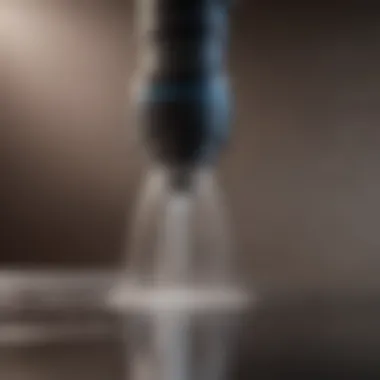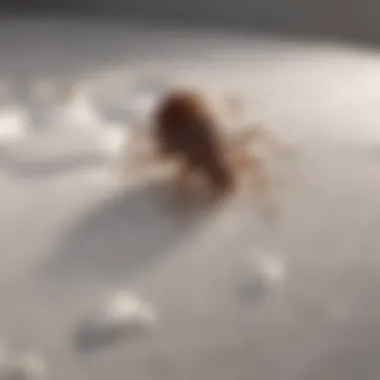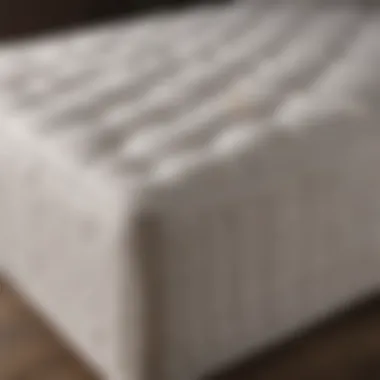Effective Steam Cleaning to Eliminate Bed Bugs


Intro
Bed bugs are a pervasive problem in many homes. Their presence can disrupt sleep and cause significant distress. This guide examines steam cleaning, a method renowned for its effectiveness against these pests. Understanding the biology of bed bugs is essential to comprehending why steam cleaning works. Furthermore, the steam cleaning process will be laid out clearly. Afterward, best practices for preventing infestations and maintaining a bed bug-free environment will be discussed. By the end, homeowners will gain valuable insights into achieving a pest-free sleeping area.
The Biology of Bed Bugs
Bed bugs are small, wingless insects that feed on blood. They are usually active at night, making them difficult to spot. Adult bed bugs can live several months without feeding, meaning a small infestation can grow quickly if left untreated. They reproduce rapidly. A female can lay hundreds of eggs in her lifetime, which hatch into nymphs. Understanding their life cycle is key to eliminating them effectively.
Why Steam Cleaning is Effective
Steam cleaning utilizes high temperatures to kill bed bugs and their eggs. The steam penetrates into mattresses and bedding, effectively reaching places where bugs hide. Typical steam cleaners heat water to around 200°F, which is well above the temperature needed to exterminate bed bugs. Beyond killing, steam cleaning also removes allergens and dust from mattresses, contributing to a healthier sleep environment.
"Steam cleaning not only eradicates bed bugs but also helps maintain a clean sleeping surface."
The Steam Cleaning Process
The steam cleaning process involves several steps:
- Preparation: Remove beddings, such as sheets and pillowcases. This allows for direct access to the mattress and helps prevent cross-contamination.
- Vacuuming: Prior to steaming, vacuum the mattress to remove loose dirt and debris. This step enhances the effectiveness of steam cleaning.
- Steam Application: Use a steam cleaner with a nozzle attachment. Begin at one end of the mattress and work towards the other, maintaining a slow pace. Ensure steam penetrates all seams and folds.
- Drying: Allow the mattress to dry completely before replacing beddings. Make sure to ventilate the room to speed up the drying process.
- Post-cleaning Inspection: After cleaning, inspect the mattress for signs of remaining bed bugs or new infestations.
Best Practices for Prevention
After steam cleaning, it's important to adopt preventive measures:
- Use protective covers: Mattress encasements can prevent bed bugs from entering or escaping.
- Regular cleaning: Vacuum the bedroom frequently and wash bedding regularly in hot water.
- Minimize clutter: Reducing clutter allows for easier cleaning and inspection.
- Monitoring: Utilize bed bug monitors to alert you to any new infestations early.
Ending
Steam cleaning provides a robust solution to eliminate bed bugs from mattresses. By understanding their biology, following the cleaning process, and implementing preventive measures, homeowners can maintain a pest-free sleeping space. A clean and safe environment is crucial for quality sleep. This guide serves as a resource for those struggling with bed bug issues, aiming to restore comfort to their homes.
Understanding Bed Bugs
Understanding bed bugs is crucial for effective pest control, especially for homeowners concerned about the comfort and safety of their living spaces. The significance of this topic lies in its multi-faceted approach to tackling bed bug infestations and ensuring a clean and healthy home environment. By comprehensively understanding bed bugs, one can better identify signs of an infestation, understand their biology, and take appropriate measures to eradicate and prevent their presence.
Biology and Lifecycle of Bed Bugs
Bed bugs, scientifically known as Cimex lectularius, are small, nocturnal insects that feed on the blood of warm-blooded animals, particularly humans. Their size typically ranges from 1 to 5 mm in length, resembling an apple seed. Understanding their lifecycle is key in developing effective eradication strategies.
- Egg Stage: A female bed bug can lay up to five eggs daily, which are about the size of a pinhead and white in color. These eggs hatch within 6 to 10 days.
- Nymph Stage: Once hatched, nymphs go through several molts before reaching adulthood. The entire nymph stage lasts approximately 5 weeks under favorable conditions, requiring a host to feed on for each molt.
- Adult Stage: Adult bed bugs can live for months without food, making them particularly resilient pests. Their lifespan typically ranges from 6 months to a year, and they can reproduce quickly, resulting in a thriving population if not controlled.
Each stage in this lifecycle presents an opportunity for intervention, particularly during the nymph stage when bed bugs are most vulnerable.
Signs of Bed Bug Infestation
Identifying bed bug infestations early can be challenging, but knowing the telltale signs is critical. Common indicators of a bed bug problem include:
- Bites: Small, red, itchy welts appearing on the skin, primarily in clusters or lines. They typically occur overnight while the person is sleeping.
- Spotting: Dark spots on bedding or furniture, which are fecal matter left by bed bugs after feeding.
- Shed Skins: Nymphs shed their exoskeletons as they mature; finding these skins in cracks and crevices can indicate an infestation.
- Visible Bugs: Adult or nymph bed bugs may be seen in the seams of mattresses, behind bed frames, or in other secluded places.
Awareness of these signs is essential for timely interventions, thus reducing the risk of a larger infestation.
Health Risks Associated with Bed Bugs
Bed bugs are not known to transmit diseases, but their presence can lead to significant health concerns. The most immediate risk is the allergic reaction caused by the bed bug bites, which can vary in severity from person to person. Scratching the bites can lead to secondary infections, introducing further health complications.


In many cases, the psychological impact of suffering a bed bug infestation can be profound, leading to anxiety, insomnia, and a general feeling of discomfort in one's own home. This stress can be exacerbated by the stigma associated with bed bugs, which are often linked with uncleanliness.
Understanding the biology, signs of infestation, and associated health risks is the first step in effectively addressing bed bug issues. This knowledge not only enhances eradication efforts but also improves overall peace of mind, making it easier to maintain a healthy living environment.
Preamble to Steam Cleaning
Steam cleaning is an effective method for addressing various cleanliness concerns within the home. When considering how to eliminate bed bugs from a mattress, understanding the steam cleaning process becomes crucial. The method uses high-temperature steam to sanitize surfaces and kill pests, including bed bugs and their eggs. This makes it a noteworthy option for anyone dealing with issues related to these resilient pests.
The importance of steam cleaning lies in its dual function: it not only eradicates bed bugs but also minimizes allergens. Individuals with sensitivities or respiratory issues may benefit from employing steam cleaning as part of their regular cleaning routine. High heat is known to kill other allergens, such as dust mites and mold, creating a healthier environment overall.
In this section, we will explore specific elements of steam cleaning, including its definition, operation, and the distinct advantages it offers for pest control. By familiarizing oneself with the process, homeowners and cleaning enthusiasts can develop a comprehensive strategy to maintain their living spaces free from pests and allergens.
What is Steam Cleaning?
Steam cleaning is a cleaning method that utilizes vaporized water to remove dirt and grime from surfaces. This technique has gained popularity due to its efficiency and non-toxic nature. Unlike traditional cleaning methods that rely on chemicals, steam cleaning employs heat to sanitize various materials, making it environmentally friendly.
During steam cleaning, water is heated to high temperatures, usually between 200°F to 300°F, producing vapor that is directed at surfaces. The intense heat works to loosen dirt particles, kill bacteria, and eliminate pests such as bed bugs. Steam cleaners are versatile and can be used on a range of surfaces, from carpets to upholstery and, most importantly, mattresses.
How Steam Cleaning Works
The process of steam cleaning involves several key steps. First, water is poured into a steam cleaner. This device has internal components that heat the water to produce steam. Once the steam is generated, it is expelled through a nozzle attached to the cleaner. The direct contact between steam and the surface to be treated allows for effective penetration, reaching deep into materials.
When steam meets the surface, it heats the area immediately. This extreme heat affects living organisms like bed bugs, as it can kill them almost instantly.
"The high temperature is crucial for effective bed bug eradication, killing both adults and nymphs quickly."
Moreover, the moisture left behind during the process is minimal compared to traditional cleaning methods, which helps prevent water damage and mildew. The process is straightforward; however, attention to detail during application is important to ensure thoroughness and maximize efficacy.
Benefits of Steam Cleaning for Allergens
Steam cleaning carries several benefits beyond bed bug eradication. One of the primary advantages is its ability to eliminate allergens. Dust mites, pet dander, and mold spores are common culprits that can exacerbate allergies and breathing problems. The high temperature of steam can kill these allergens on contact, leading to cleaner air.
Benefits of steam cleaning for allergens include:
- Sanitization: The heat effectively sanitizes surfaces, reducing the chances of allergic reactions.
- Chemical-Free: Unlike many conventional cleaning products, steam does not require harsh chemicals.
- Deep Cleaning: Steam penetrates deep into materials, thoroughly cleaning and removing embedded allergens.
- Speed: The process can be quicker than traditional cleaning, yielding immediate results in many cases.
In summary, steam cleaning emerges as a powerful tool for not only removing bed bugs but also maintaining a house free from allergens. Understanding its definition, operational principles, and benefits lays the groundwork for implementing this cleaning strategy effectively in your living environment.
Preparing for Steam Cleaning
Preparing for steam cleaning your mattress is a crucial step in the battle against bed bugs. The effectiveness of the steam cleaning process can be significantly influenced by how well you prepare the area and the tools you have at your disposal. Proper preparation not only improves the efficacy of the cleaning, but it also ensures your safety and the safety of your belongings. Here are several key aspects to consider.
Gathering Required Supplies
To conduct an effective steam cleaning, you must first gather the necessary supplies. A steam cleaner is essential; it should have a nozzle suitable for mattresses. Look for one that can reach high temperatures, ideally above 160°F, as this is the temperature that can kill bed bugs and their eggs. Additionally, you will need:
- A microfiber cloth to wipe down surfaces after steaming.
- Distilled water for your steam cleaner, as tap water may contain minerals that can build up inside the machine.
- A vacuum cleaner with HEPA filters to remove any debris before you begin.
Using quality materials and tools will enhance your overall cleaning experience. Don't forget to check the steam cleaner's manual for specific instructions or warnings.
Clearing the Area
Before beginning the cleaning process, it is important to clear the area around your mattress. Move any nearby furniture or items. This not only provides you with enough space to maneuver the steam cleaner but also prevents accidental damage to other belongings. Vacuum the surrounding area to pick up any dust or debris, which may harbor additional bed bugs. Clearing the area ensures that steam can penetrate all crevices in the mattress, thus maximizing its effectiveness against pests.


Protecting Surrounding Items
Once the area is clear, it is still necessary to take precautions to protect surrounding items. Cover any furniture items that cannot be moved with a towel or plastic sheeting. This precaution helps to prevent water damage and any residue from the steam cleaning. If curtains or delicate items are within close proximity to the mattress, consider removing them entirely.
When steam cleaning, the moisture can create a potential hazard for electronic items as well. Therefore, ensure that devices such as nightlights or phone chargers are safely stored away from the cleaning area. This protects both your belongings and ensures a clean, efficient process.
Preparation is key. A well-prepared area enhances the steam cleaning process, ensuring effective results.
In summary, preparing for steam cleaning involves gathering the right supplies, clearing the area, and protecting surrounding items from potential damage. Taking these steps will lay the foundation for a successful cleaning experience.
The Steam Cleaning Process
The steam cleaning process is a critical component in the battle against bed bugs. Understanding how to utilize this method effectively can significantly enhance the chances of completely eradicating these pests from your mattress. Steam cleaning is not merely a surface cleaning method; it penetrates deep into fabrics, killing bed bugs and their eggs through high temperatures.
Proper steam cleaning can disrupt the lifecycle of bed bugs, which is essential for long-term solutions. According to various sources, an effective steam cleaner can reach temperatures exceeding 200 degrees Fahrenheit, which is lethal for bed bugs. Hence, the method is both eco-friendly and chemical-free, making it safe for indoor use.
When considering steam cleaning, homeowners should also take note of specific elements to ensure success. This includes knowing where to focus the steam, the right duration of exposure, and maintaining a steady speed to adequately treat the affected areas without causing damage.
Identifying Affected Areas
The first step in the steam cleaning process is identifying the areas most affected by bed bugs. This involves examining your mattress and surrounding furniture thoroughly. Pay close attention to seams, crevices, and any part where fabric meets fabric. Use a flashlight to make the inspection easier. It is essential to look for signs such as:
- Dark spots (bed bug excrement)
- Shed skins
- Living bugs themselves
In addition to the mattress, inspect headboards, bed frames, and nearby furnishings. These areas can also harbor bed bugs. Identifying hot spots before starting the cleaning not only saves time but boosts the efficiency of the cleaning task.
Using the Steam Cleaner Effectively
To maximize the efficacy of the steam cleaner, following specific strategies is important. First, make sure to choose a steam cleaner equipped with a nozzle attachment, which allows for better penetration into folds and tight spots on the mattress. Here are some effective strategies:
- Check Water Levels: Use distilled water to prolong the life of your steam cleaner.
- Temperature Settings: Ensure your steam cleaner reaches at least 200°F.
- Movement Technique: Move slowly across affected areas. This ensures the steam has enough time to eliminate any eggs or pests.
- Cover Surface Area: Don’t forget to steam all surfaces of the mattress, including the sides and underneath, if accessible.
By applying adequate steam seamlessly over the areas identified, you can greatly reduce the presence of bed bugs.
Post-Cleaning Inspection
Once the steam cleaning is complete, conducting a post-cleaning inspection is vital. This step helps confirm whether the steam cleaning was effective in eliminating bed bugs. Look for any remaining signs of bed bugs, including new fecal matter or the appearance of live insects.
If everything seems clean, allow the mattress to dry thoroughly, as moisture can attract further infestations. To prevent future occurrences, consider regularly inspecting your sleeping area and establishing a consistent cleaning routine.
"A thorough inspection following steam cleaning can reveal areas that require further attention or additional treatment,"
Preventive Measures Against Bed Bugs
Preventing bed bugs is a critical aspect of maintaining a safe and healthy sleep environment. An infestation can lead to not only discomfort but also significant stress and financial burden. Taking proactive steps is better than addressing an infestation after it has occurred. The importance of preventive measures cannot be overstated; they can save you time and resources while providing peace of mind.
Choosing the Right Mattress Protector
A strong mattress protector can act as a first line of defense against bed bugs. This is a specially designed covering that fits tightly over your mattress. It's essential to choose a protector that is labeled as "bed bug proof." These protectors typically feature a zippered enclosure, preventing bed bugs from entering or exiting the mattress.
Investing in a high-quality protector not only protects against bed bugs, but also shields your mattress from spills, allergens, and dust mites. It's advisable to wash your mattress protector every few months and check for any signs of wear or damage. A compromised protector can diminish its effectiveness against bugs.
Regular Cleaning Practices


Establishing consistent cleaning routines can deter bed bugs from invading your home. Regularly vacuuming your sleeping area is crucial. Pay attention to cracks and crevices in your mattress, bed frame, and baseboards. Dispose of vacuum bags promptly to prevent any potential escapees.
Besides vacuuming, consider washing your bedding regularly in hot water. The heat kills any potential bugs or eggs that might be hiding in linens. Aim to wash sheets and pillowcases weekly, incorporating duvet covers and mattress pads once a month.
Another effective practice is to declutter your bedroom space. This reduces hiding spots for bed bugs and makes cleaning more manageable.
Monitoring for Recurring Infestations
Once you have taken preventive steps, ongoing monitoring is vital. Pay attention to any signs of bed bugs, such as small brown or red spots on your mattress or bedding. Also, be alert to any unusual bites on your skin. If you notice signs of an infestation, act quickly and re-evaluate your cleaning and protective measures.
Periodically inspect your bedding, mattress, and surrounding areas for indications of bed bugs. Maintaining an awareness of your environment can lead to early detection. If you find live bed bugs or evidence of their presence, you may need to reassess your steam cleaning approach or seek professional assistance.
"An ounce of prevention is worth a pound of cure" when dealing with bed bugs. Proactive measures can significantly reduce the risk of infestations.
By implementing these preventive measures, homeowners can create a more resilient barrier against bed bug infestations. Staying vigilant and adopting best practices will help maintain a peaceful, pest-free sleeping environment.
Evaluating the Effectiveness of Steam Cleaning
Evaluating the effectiveness of steam cleaning is essential in understanding its role in eliminating bed bugs. This process does more than just remove visible pests; it addresses the underlying issues that contribute to infestations. By assessing how well steam cleaning eliminates these insects and prevents future occurrences, homeowners can make more informed choices regarding their cleaning habits and pest control strategies.
Immediate Results vs Long-Term Solutions
When steam cleaning a mattress, immediate results can be observed by seeing dead bed bugs and their eggs. The high temperature of the steam, usually over 200°F, kills bed bugs instantly upon contact. This gives a sense of reassurance that the cleaning has worked. However, immediate results should not be the only measure of effectiveness.
Steam cleaning needs to be part of a broader strategy. While it can eradicate existing bugs, it does not provide long-term prevention unless paired with other measures. Regular maintenance and preventive practices must be established. Thus, immediate effectiveness should be evaluated alongside long-term solutions that engage continuous vigilance and cleaning.
Combining Methods for Optimal Results
To achieve the best outcomes in bed bug eradication, combining steam cleaning with additional pest control methods is advisable. Steam cleaning acts as a powerful tool, but when integrated with other techniques, the outcomes improve significantly.
Consider methods such as:
- Regular vacuuming: Use a vacuum cleaner with a HEPA filter to remove any pests that the steam may miss.
- Encasements: Place your mattress and box spring in bed bug-proof encasements to trap any remaining bugs and prevent new infestations.
- Chemical treatments: Although steam primarily offers a non-toxic solution, some homeowners may opt for insecticides to create a multi-dimensional approach to bed bug control.
The combination of these methods can optimize results and provide a safer sleeping environment. By adopting multiple strategies, you effectively break the lifecycle of bed bugs, reducing the chances of their return.
Seeking Professional Help
In some cases, steam cleaning may not suffice to eliminate a severe bed bug infestation. When the situation escalates, seeking professional help becomes necessary. Pest control experts possess the specialized equipment and knowledge needed to assess the depth of the infestation and apply suitable treatments.
Professionals can offer:
- In-depth inspections: Thorough diagnostics that identify hidden infestation sites, including walls and electrical sockets.
- Advanced steaming technology: Types of steamers not typically available for home use can penetrate surfaces more effectively.
- Tailored solutions: Custom strategies for pest management based on the severity of the issue and specific characteristics of the home environment.
Ultimately, evaluating the effectiveness of steam cleaning requires a balanced perspective. It is a significant component of a comprehensive approach to pest control, but not a standalone solution. By understanding the immediate effects, considering integrations with other methods, and recognizing when professional intervention is necessary, homeowners can better manage their environments against bed bugs.
Culmination
In this discussion surrounding bed bugs and steam cleaning, it is critical to appreciate the multifaceted approach required for effective pest control. The complexity of eliminating bed bugs must not be understated. Homeowners need to understand that steam cleaning is only one facet of a complete strategy. In this article, we have explored the biology and habits of these pests, the intricacies of the steam cleaning process, preventative measures, and evaluating the effectiveness of various techniques. Each of these elements plays a distinct role in maintaining a pest-free environment.
Summarizing Key Points
To summarize, we covered various essential points:
- Understanding the Biology of Bed Bugs: Knowledge of bed bug behavior and lifecycle is crucial for effective treatment.
- Steam Cleaning Process: Effective techniques ensure maximum reach and destruction of these pests.
- Preventive Measures: Choosing the right solutions, such as mattress protectors, enhances long-term protection against infestations.
- Evaluation of Effectiveness: Immediate results can be misleading; understanding long-term implications is vital for success.
These points reinforce the fact that bed bug eradication is an ongoing task, requiring persistent effort and informed strategies.
Final Thoughts on Maintaining a Bed Bug-Free Home
Maintaining a bed bug-free home is not solely about immediate fixes but involves establishing consistent cleaning practices and vigilance. Regular inspections and proper cleaning routines can greatly reduce the likelihood of reinfestation. Homeowners are encouraged to adopt a holistic approach, combining steam cleaning with other methods as discussed. Confidently managing your sleep environment not only enhances comfort but also significantly contributes to health and well-being. With knowledge and diligence, a bed bug-free home is an achievable goal.















